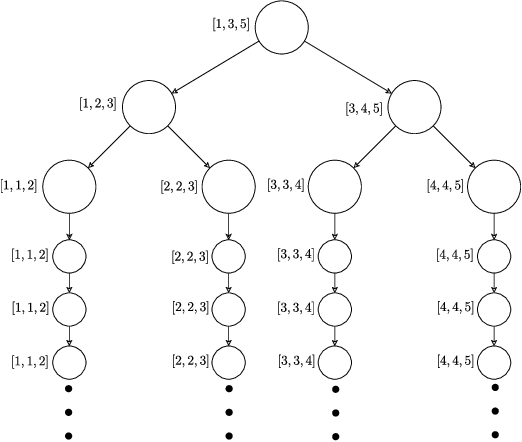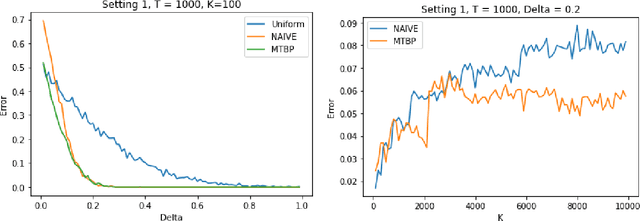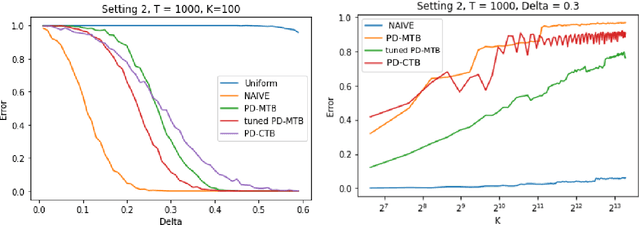Alexandra Carpentier
LMO, CELESTE
Statistical and computational challenges in ranking
Dec 24, 2025Abstract:We consider the problem of ranking $n$ experts according to their abilities, based on the correctness of their answers to $d$ questions. This is modeled by the so-called crowd-sourcing model, where the answer of expert $i$ on question $k$ is modeled by a random entry, parametrized by $M_{i,k}$ which is increasing linearly with the expected quality of the answer. To enable the unambiguous ranking of the experts by ability, several assumptions on $M$ are available in the literature. We consider here the general isotonic crowd-sourcing model, where $M$ is assumed to be isotonic up to an unknown permutation $π^*$ of the experts - namely, $M_{π^{*-1}(i),k} \geq M_{π^{*-1}(i+1),k}$ for any $i\in [n-1], k \in [d]$. Then, ranking experts amounts to constructing an estimator of $π^*$. In particular, we investigate here the existence of statistically optimal and computationally efficient procedures and we describe recent results that disprove the existence of computational-statistical gaps for this problem. To provide insights on the key ideas, we start by discussing simpler and yet related sub-problems, namely sub-matrix detection and estimation. This corresponds to specific instances of the ranking problem where the matrix $M$ is constrained to be of the form $λ\mathbf 1\{S\times T\}$ where $S\subset [n], T\subset [d]$. This model has been extensively studied. We provide an overview of the results and proof techniques for this problem with a particular emphasis on the computational lower bounds based on low-degree polynomial methods. Then, we build upon this instrumental sub-problem to discuss existing results and algorithmic ideas for the general ranking problem.
Phase Transition for Stochastic Block Model with more than $\sqrt{n}$ Communities
Sep 19, 2025Abstract:Predictions from statistical physics postulate that recovery of the communities in Stochastic Block Model (SBM) is possible in polynomial time above, and only above, the Kesten-Stigum (KS) threshold. This conjecture has given rise to a rich literature, proving that non-trivial community recovery is indeed possible in SBM above the KS threshold, as long as the number $K$ of communities remains smaller than $\sqrt{n}$, where $n$ is the number of nodes in the observed graph. Failure of low-degree polynomials below the KS threshold was also proven when $K=o(\sqrt{n})$. When $K\geq \sqrt{n}$, Chin et al.(2025) recently prove that, in a sparse regime, community recovery in polynomial time is possible below the KS threshold by counting non-backtracking paths. This breakthrough result lead them to postulate a new threshold for the many communities regime $K\geq \sqrt{n}$. In this work, we provide evidences that confirm their conjecture for $K\geq \sqrt{n}$: 1- We prove that, for any density of the graph, low-degree polynomials fail to recover communities below the threshold postulated by Chin et al.(2025); 2- We prove that community recovery is possible in polynomial time above the postulated threshold, not only in the sparse regime of~Chin et al., but also in some (but not all) moderately sparse regimes by essentially counting clique occurence in the observed graph.
Low-degree lower bounds via almost orthonormal bases
Sep 11, 2025Abstract:Low-degree polynomials have emerged as a powerful paradigm for providing evidence of statistical-computational gaps across a variety of high-dimensional statistical models [Wein25]. For detection problems -- where the goal is to test a planted distribution $\mathbb{P}'$ against a null distribution $\mathbb{P}$ with independent components -- the standard approach is to bound the advantage using an $\mathbb{L}^2(\mathbb{P})$-orthonormal family of polynomials. However, this method breaks down for estimation tasks or more complex testing problems where $\mathbb{P}$ has some planted structures, so that no simple $\mathbb{L}^2(\mathbb{P})$-orthogonal polynomial family is available. To address this challenge, several technical workarounds have been proposed [SW22,SW25], though their implementation can be delicate. In this work, we propose a more direct proof strategy. Focusing on random graph models, we construct a basis of polynomials that is almost orthonormal under $\mathbb{P}$, in precisely those regimes where statistical-computational gaps arise. This almost orthonormal basis not only yields a direct route to establishing low-degree lower bounds, but also allows us to explicitly identify the polynomials that optimize the low-degree criterion. This, in turn, provides insights into the design of optimal polynomial-time algorithms. We illustrate the effectiveness of our approach by recovering known low-degree lower bounds, and establishing new ones for problems such as hidden subcliques, stochastic block models, and seriation models.
Optimal level set estimation for non-parametric tournament and crowdsourcing problems
Aug 27, 2024



Abstract:Motivated by crowdsourcing, we consider a problem where we partially observe the correctness of the answers of $n$ experts on $d$ questions. In this paper, we assume that both the experts and the questions can be ordered, namely that the matrix $M$ containing the probability that expert $i$ answers correctly to question $j$ is bi-isotonic up to a permutation of it rows and columns. When $n=d$, this also encompasses the strongly stochastic transitive (SST) model from the tournament literature. Here, we focus on the relevant problem of deciphering small entries of $M$ from large entries of $M$, which is key in crowdsourcing for efficient allocation of workers to questions. More precisely, we aim at recovering a (or several) level set $p$ of the matrix up to a precision $h$, namely recovering resp. the sets of positions $(i,j)$ in $M$ such that $M_{ij}>p+h$ and $M_{i,j}<p-h$. We consider, as a loss measure, the number of misclassified entries. As our main result, we construct an efficient polynomial-time algorithm that turns out to be minimax optimal for this classification problem. This heavily contrasts with existing literature in the SST model where, for the stronger reconstruction loss, statistical-computational gaps have been conjectured. More generally, this shades light on the nature of statistical-computational gaps for permutations models.
A simple and improved algorithm for noisy, convex, zeroth-order optimisation
Jun 26, 2024Abstract:In this paper, we study the problem of noisy, convex, zeroth order optimisation of a function $f$ over a bounded convex set $\bar{\mathcal X}\subset \mathbb{R}^d$. Given a budget $n$ of noisy queries to the function $f$ that can be allocated sequentially and adaptively, our aim is to construct an algorithm that returns a point $\hat x\in \bar{\mathcal X}$ such that $f(\hat x)$ is as small as possible. We provide a conceptually simple method inspired by the textbook center of gravity method, but adapted to the noisy and zeroth order setting. We prove that this method is such that the $f(\hat x) - \min_{x\in \bar{\mathcal X}} f(x)$ is of smaller order than $d^2/\sqrt{n}$ up to poly-logarithmic terms. We slightly improve upon existing literature, where to the best of our knowledge the best known rate is in [Lattimore, 2024] is of order $d^{2.5}/\sqrt{n}$, albeit for a more challenging problem. Our main contribution is however conceptual, as we believe that our algorithm and its analysis bring novel ideas and are significantly simpler than existing approaches.
Active clustering with bandit feedback
Jun 17, 2024
Abstract:We investigate the Active Clustering Problem (ACP). A learner interacts with an $N$-armed stochastic bandit with $d$-dimensional subGaussian feedback. There exists a hidden partition of the arms into $K$ groups, such that arms within the same group, share the same mean vector. The learner's task is to uncover this hidden partition with the smallest budget - i.e., the least number of observation - and with a probability of error smaller than a prescribed constant $\delta$. In this paper, (i) we derive a non-asymptotic lower bound for the budget, and (ii) we introduce the computationally efficient ACB algorithm, whose budget matches the lower bound in most regimes. We improve on the performance of a uniform sampling strategy. Importantly, contrary to the batch setting, we establish that there is no computation-information gap in the active setting.
Online Learning with Feedback Graphs: The True Shape of Regret
Jun 05, 2023Abstract:Sequential learning with feedback graphs is a natural extension of the multi-armed bandit problem where the problem is equipped with an underlying graph structure that provides additional information - playing an action reveals the losses of all the neighbors of the action. This problem was introduced by \citet{mannor2011} and received considerable attention in recent years. It is generally stated in the literature that the minimax regret rate for this problem is of order $\sqrt{\alpha T}$, where $\alpha$ is the independence number of the graph, and $T$ is the time horizon. However, this is proven only when the number of rounds $T$ is larger than $\alpha^3$, which poses a significant restriction for the usability of this result in large graphs. In this paper, we define a new quantity $R^*$, called the \emph{problem complexity}, and prove that the minimax regret is proportional to $R^*$ for any graph and time horizon $T$. Introducing an intricate exploration strategy, we define the \mainAlgorithm algorithm that achieves the minimax optimal regret bound and becomes the first provably optimal algorithm for this setting, even if $T$ is smaller than $\alpha^3$.
Active Ranking of Experts Based on their Performances in Many Tasks
Jun 05, 2023Abstract:We consider the problem of ranking n experts based on their performances on d tasks. We make a monotonicity assumption stating that for each pair of experts, one outperforms the other on all tasks. We consider the sequential setting where in each round, the learner has access to noisy evaluations of actively chosen pair of expert-task, given the information available up to the actual round. Given a confidence parameter $\delta$ $\in$ (0, 1), we provide strategies allowing to recover the correct ranking of experts and develop a bound on the total number of queries made by our algorithm that hold with probability at least 1 -- $\delta$. We show that our strategy is adaptive to the complexity of the problem (our bounds are instance dependent), and develop matching lower bounds up to a poly-logarithmic factor. Finally, we adapt our strategy to the relaxed problem of best expert identification and provide numerical simulation consistent with our theoretical results.
The price of unfairness in linear bandits with biased feedback
Mar 18, 2022
Abstract:Artificial intelligence is increasingly used in a wide range of decision making scenarios with higher and higher stakes. At the same time, recent work has highlighted that these algorithms can be dangerously biased, and that their results often need to be corrected to avoid leading to unfair decisions. In this paper, we study the problem of sequential decision making with biased linear bandit feedback. At each round, a player selects an action described by a covariate and by a sensitive attribute. She receives a reward corresponding to the covariates of the action that she has chosen, but only observe a biased evaluation of this reward, where the bias depends on the sensitive attribute. To tackle this problem, we design a Fair Phased Elimination algorithm. We establish an upper bound on its worst-case regret, showing that it is smaller than C$\kappa$ 1/3 * log(T) 1/3 T 2/3 , where C is a numerical constant and $\kappa$ * an explicit geometrical constant characterizing the difficulty of bias estimation. The worst case regret is higher than the dT 1/2 log(T) regret rate obtained under unbiased feedback. We show that this rate cannot be improved for all instances : we obtain lower bounds on the worst-case regret for some sets of actions showing that this rate is tight up to a sub-logarithmic factor. We also obtain gap-dependent upper bounds on the regret, and establish matching lower bounds for some problem instance. Interestingly, the gap-dependent rates reveal the existence of non-trivial instances where the problem is no more difficult than its unbiased counterpart.
Problem Dependent View on Structured Thresholding Bandit Problems
Jun 18, 2021



Abstract:We investigate the problem dependent regime in the stochastic Thresholding Bandit problem (TBP) under several shape constraints. In the TBP, the objective of the learner is to output, at the end of a sequential game, the set of arms whose means are above a given threshold. The vanilla, unstructured, case is already well studied in the literature. Taking $K$ as the number of arms, we consider the case where (i) the sequence of arm's means $(\mu_k)_{k=1}^K$ is monotonically increasing (MTBP) and (ii) the case where $(\mu_k)_{k=1}^K$ is concave (CTBP). We consider both cases in the problem dependent regime and study the probability of error - i.e. the probability to mis-classify at least one arm. In the fixed budget setting, we provide upper and lower bounds for the probability of error in both the concave and monotone settings, as well as associated algorithms. In both settings the bounds match in the problem dependent regime up to universal constants in the exponential.
 Add to Chrome
Add to Chrome Add to Firefox
Add to Firefox Add to Edge
Add to Edge